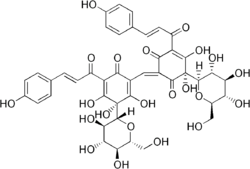- Carthamin
-
Carthamin[1]  (2Z,6S)-6-β-D-Glucopyranosyl -2-[ [(3S) -3-β-D-glucopyranosyl-2,3,4-trihydroxy -5-[(2E)-3-(4-hydroxyphenyl) -1-oxo-2-propenyl] -6-oxo-1,4-cyclohexadien-1-yl]methylene] -5,6-dihydroxy -4-[(2E)-3-(4-hydroxyphenyl) -1-oxo-2-propenyl] -4-cyclohexene-1,3-dioneOther namesCarthamine
(2Z,6S)-6-β-D-Glucopyranosyl -2-[ [(3S) -3-β-D-glucopyranosyl-2,3,4-trihydroxy -5-[(2E)-3-(4-hydroxyphenyl) -1-oxo-2-propenyl] -6-oxo-1,4-cyclohexadien-1-yl]methylene] -5,6-dihydroxy -4-[(2E)-3-(4-hydroxyphenyl) -1-oxo-2-propenyl] -4-cyclohexene-1,3-dioneOther namesCarthamine
Carthamic acid
C.I. Natural Red 26
Safflower redIdentifiers CAS number 36338-96-2 PubChem 11968069 ChemSpider 21106423 
Jmol-3D images Image 1
Image 2- O=C(/C=C/C3=C C=C(O)C=C3) C (C(/C1=C/C2=C(O) [C@]([C@@]6([H])[C@H](O) [C@@H](O)[C@H](O)[C@@H](CO)O6)(O) C (O)= C (C(/C=C/C5=CC=C(O)C=C5) =O)C2=O)=O)= C(O)[C@]([C@]4([H]) O [C@H](CO)[C@@H](O)[C@H] (O)[C@H]4O)(O)C1=O
Oc1ccc(cc1)/C=CC(\O)=C6\C(\O)=C(\C=C/4\C(=O)[C@](O)(C2O[C@H](CO)[C@@H](O)[C@H](O)[C@H]2O)C(=O)C(\C(=O)/C=C/c3ccc(O)cc3)=C\4\O)C(=O)[C@@](O)(C5O[C@H](CO)[C@@H](O)[C@H](O)[C@H]5O)C6=O
- InChI=1S/C43H42O22/c44-14-24-30(52)32(54)34(56)40(64-24)42(62)36(58)20(28(50)26(38(42)60)22(48)11-5-16-1-7-18(46)8-2-16)13-21-29(51)27(23(49)12-6-17-3-9-19(47)10-4-17)39(61)43(63,37(21)59)41-35(57)33(55)31(53)25(15-45)65-41/h1-13,24-25,30-35,40-41,44-48,50-57,62-63H,14-15H2/b11-5+,12-6+,21-13+,26-22+/t24-,25-,30-,31-,32+,33+,34-,35-,40?,41?,42+,43-/m1/s1

Key: UZPQVEVQJJKELH-YOKGVFNOSA-N InChI=1/C43H42O22/c44-14-24-30(52)32(54)34(56)40(64-24)42(62)36(58)20(28(50)26(38(42)60)22(48)11-5-16-1-7-18(46)8-2-16)13-21-29(51)27(23(49)12-6-17-3-9-19(47)10-4-17)39(61)43(63,37(21)59)41-35(57)33(55)31(53)25(15-45)65-41/h1-13,24-25,30-35,40-41,44-48,50-57,62-63H,14-15H2/b11-5+,12-6+,21-13+,26-22+/t24-,25-,30-,31-,32+,33+,34-,35-,40?,41?,42+,43-/m1/s1
InChI=1/C43H42O22/c44-14-24-30(52)32(54)34(56)40(64-24)42(62)36(58)20(28(50)26(38(42)60)22(48)11-5-16-1-7-18(46)8-2-16)13-21-29(51)27(23(49)12-6-17-3-9-19(47)10-4-17)39(61)43(63,37(21)59)41-35(57)33(55)31(53)25(15-45)65-41/h1-13,24-25,30-35,40-41,44-48,50-57,62-63H,14-15H2/b11-5+,12-6+,21-13+,26-22+/t24-,25-,30-,31-,32+,33+,34-,35-,40?,41?,42+,43-/m1/s1
Key: UZPQVEVQJJKELH-YOKGVFNOBD
Properties Molecular formula C43H42O22 Molar mass 910.78 g/mol Exact mass 910.216773 Appearance Red powder Solubility in water Slightly soluble  (verify) (what is:
(verify) (what is:  /
/ ?)
?)
Except where noted otherwise, data are given for materials in their standard state (at 25 °C, 100 kPa)Infobox references Carthamin is a natural red pigment derived from safflower (Carthamus tinctorius), earlier known as carthamine.[2] It is used as a dye and a food coloring. As a food additive, it is known as Natural Red 26.
Safflower has been cultivated since ancient times, and carthamin was used as a dye in ancient Egypt.[2] It was used extensively in the past for dyeing wool for the carpet industry in European countries and to create cosmetics for geisha and kabuki artists in Japan, where the color is called beni (紅).[3][4] It competed with the early synthetic dye fuchsine as a silk dye after fuchsine's 1859 discovery.[5]
It is composed of two chalconoids; the conjugated bonds being the cause of the red color. It is derived from precarthamin by a decarboxylase.[6] It should not be confused with carthamidin, another flavonoid.
References
- ^ Merck Index, 11th Edition, 1876.
- ^ a b De Candolle, Alphonse. (1885.) Origin of cultivated plants. D. Appleton & Co.: New York, p. 164. Retrieved on 2007-09-25.
- ^ Carthamus tinctorius (Safflower), a commercially viable dye for textiles. Vankar, Padma S.; Tiwari, Vandana; Shanker, Rakhi; Shivani. Asian Dyer (2004), 1(4), 25-27.
- ^ Morse, Anne Nishimura, et al. MFA Highlights: Arts of Japan. Boston: Museum of Fine Arts Publications, 2008. p161.
- ^ Chevreul, M. E. (July 1860). "Note sur les étoffes de soie teintes avec la fuchsine, et réflexions sur le commerce des étoffes de couleur." Répertoire de Pharmacie, tome XVII, p. 62. Retrieved on 2007-09-25.
- ^ Enzymatic Conversion of Precarthamin to Carthamin by a Purified Enzyme from the Yellow Petals of Safflower. Man-Ho Cho, Young-Sook Paik, and Tae-Ryong Hahn, J. Agric. Food Chem., 2000, 48 (9), pp 3917–3921
Chalconoids: Chalconoid glycosides: Carthamin | Marein | okanin 3,4,3′-trimethyl ether 4′-glucoside | okanin 4-methyl ether 4′-glucoside | okanin 4-methyl ether 4′-glucoside monoacetate | Okanin 3,4-dimethyl ether 4′-glucosideAcetylated chalconoids: Licochalcone A | Sophoradin (prenylated) | Xanthohumol (prenylated)O-methylated chalconoids Cardamomin | Okanin 3,4,3′,4′-tetramethyl etherFlavokavains Flavokavain A | Flavokavain B | Flavokavain CSynthetic Bond Geometry Glycone Aglycone biochemical families: prot · nucl · carb (glpr, alco, glys) · lipd (fata/i, phld, strd, gllp, eico) · amac/i · ncbs/i · ttpy/iCategories:- Natural phenol dyes
- Chalconoid glycosides
- Food colorings
- O=C(/C=C/C3=C C=C(O)C=C3) C (C(/C1=C/C2=C(O) [C@]([C@@]6([H])[C@H](O) [C@@H](O)[C@H](O)[C@@H](CO)O6)(O) C (O)= C (C(/C=C/C5=CC=C(O)C=C5) =O)C2=O)=O)= C(O)[C@]([C@]4([H]) O [C@H](CO)[C@@H](O)[C@H] (O)[C@H]4O)(O)C1=O
Wikimedia Foundation. 2010.
